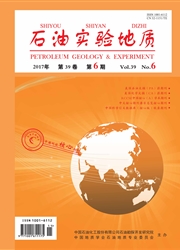

 中文摘要:
中文摘要:
基于现代实验手段,对渤海湾盆地东营凹陷古近系沙河街组沙三下亚段和沙四上亚段泥页岩孔隙进行观察分析,研究其孔径分布和孔隙度与埋深的变化关系。指出黏土矿物晶间孔、方解石晶间孔、砂质粒间孔、黄铁矿晶间孔和有机孔隙等是东营凹陷古近系泥页岩的主要孔隙类型;泥页岩中纳米级孔隙非常发育,25 nm以下孔隙占孔隙总体积的49.7%~86.3%;并阐明了孔隙度随深度的变化规律。通过对东营凹陷古近系孔隙度演化特征和影响因素的系统研究,建立了泥页岩孔隙演化模式,把东营凹陷古近系泥页岩孔隙演化划分为基本面貌形成阶段、调整改造阶段和结构滞变阶段,深入剖析了各阶段孔隙度演化规律和主控因素,认为第二和第三阶段对页岩油气储集性能的影响最大;指出具有较大的厚度、较高的有机质丰度、黄铁矿较为发育、热硫酸盐还原作用较强是泥页岩储集空间发育的有利条件。
 英文摘要:
英文摘要:
The pore characteristics of mud shales from the lower part of the third member and the upper part of the fourth member of the Paleogene Shahejie Formation in the Dongying Sag were studied through modern experimental methods. The relationships between pore size distribution,porosity and burial depth were analyzed. Five major pore types of the Paleogene mud shales in the study area were identified,including intercrystalline pores in clay minerals,intercrystalline pores in calcites,intergranular pores in sands,intercrystalline pores in pyrites,and organic pores. Nano pores were well developed in the mud shales,and the pores smaller than 25 nm accounted for 49.7% to 86.3% of total pores. The changing modes of porosity with depth are discussed. An model of how the pores in the mud shales evolved in the Paleogene in the Donging Sag was established from their characteristics and knowledge of their controlling factors. There were three evolution stages for pores in the Paleogene mud shales,including the original formation stage,the transformation stage and the hysteresis stage,among which the second and the third contributed more to the hydrocarbon storage capacity of the shales. Greater thickness,high organic abundance,rich pyrite and active thermal sulfate reduction effect were favorable conditions for reservoir development in mud shales.
 同期刊论文项目
同期刊论文项目
 同项目期刊论文
同项目期刊论文
 期刊信息
期刊信息
